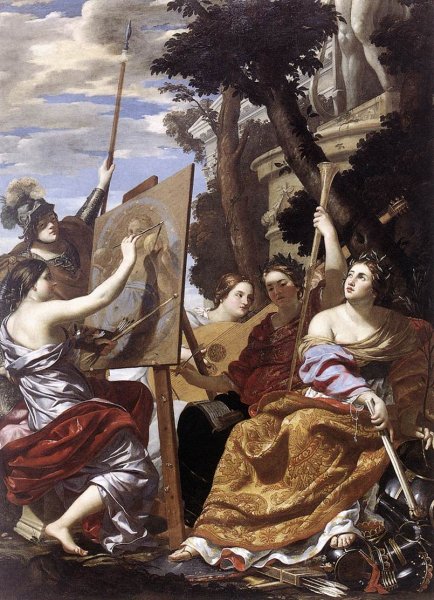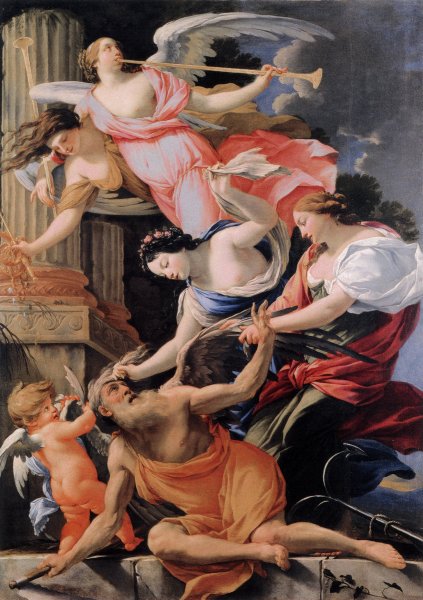Simon Vouet Biography In Details
Career

Vouet's career overshadowed today by that of Poussin, Vouet was nonetheless the most influential French painter of his generation. As the leading artist of the French school in the 1630's and 1640's Vouet did much to make Paris one of the major artistic centers of Europe. A superb draftsman, a master of the grand decoration as well as a consummate easel painter, Simon Vouet has been shown over time to be a worthy rival of the great classicist. As with his contemporaries, Valentin, Regnier and Tournier, Vouet was first attracted by the paintings of Caravaggio, the dominant influence not only on most Italian and French painters (with the notable exception of Poussin), but also on a succession of northern artists who studied in Rome. For many Vouet's early paintings, painted between his arrival in Rome in 1614 (after traveling as far afield as England, Constantinople and Venice) and about 1625, represent the very best of French Caravaggism. By the time Vouet was elected Principe (or head) of the Academy of Saint Luke in 1624 Vouet's palette had begun to lighten, his forms becoming more elegant and decorative. Although this development was progressive, first dawning in the Calvary of 1621 (Genoa, Church of the Gesu), we notice a very visible change by the time of the Holy Family with Saint John the Baptist of 1626 (San Francisco, Museum of Fine Arts).
1627-1649

Immediately upon returning to France in 1627, Vouet was put to work for the Crown and, for the next thirteen years, remained the paramount figure in Parisian artistic circles. Although not formally established as a state appointment until the reign of Louis XIV (when the post was given to Le Brun), the position of First Painter, which was accorded to Vouet soon after his return to France and which he held for most of the remainder of his life, charged him with responsibility for overseeing all the major artistic projects of the Crown. Not only was Vouet patronized by the King and Queen but, in 1630, he began the decoration of the gallery and chapel of Cardinal Richelieu's Parisian Palace as well as the chapel of his country estate at Rueil, later working for a succession of those new men who had made their fortunes during or after the wars of the Fronde.
By the early 1630s Vouet's studio had expanded, with the addition over the next decade of his brother Aubin and an increasing number of highly skilled pupils, the most notable being Eustache le Sueur, Laurent de la Hyre, Charles Poerson, Michel Corneille, Francois Perrier, Nicholas Chaperon, Michel Dorigny Charles Le Brun and Claude Mellan. From 1636-1640 Vouet was engaged in the task of decorating the gallery of the King's favorite palace of Saint Germain (both the old and new buildings) of which the paintings Allegory of Charity and Allegory of Riches (Paris, Louvre) are particularly notable examples, while providing a series of paintings for the chapels of both chateaux. He also began his splendid decorations for the Hotel Seguier, the magnificent residence of the enormously wealthy Chancellor of France. Of these the emotive and dramatic Christ on the Cross (Lyon, Musee des Beaux Arts) is the most spectacular.
After returning to work in what was now the Palais Royal (formerly Richelieu's Palace) for the dowager Queen Regent from 1644-45, Vouet received a commission to decorate the Hotel Bretonvilliers, producing in 1646 one of his last great classical painting, Saturn, conquered by Cupid, Venus and Hope (Bourges, Musee du Berry). The recent Vouet exhibition held at the Grand Palais in Paris in the winter of 1990-91 culminated with a splendid altar-painting produced for the Church of Saint-Mederic, The Adoration of the Divine Name by Four Saints. Although dated by Crelly to the mid-1630s this painting is more convincingly dated by the authors of the exhibition catalogue to the years 1645-49, demonstrating that even towards the end of his life Vouet could create a brilliant and inspirational masterpiece painting.
Works

In addition to the complex and elaborate multi figure composition paintings Vouet produced throughout his career, he also painted a series of charming and sensitive paintings of the Madonna and Child on a more modest scale. Their popularity may be attested to by their continued publication as engravings some years after the artist's death (one, by Jean Boulanger, as late as 1661). These paintings were also extensively imitated or copied by other artists, most competently by his pupils Dorigny and Mellan, who remained faithful to his artistic legacy throughout their subsequent careers.
Of his later paintings, this splendid Holy Family was until recently only known from the engraving in reverse by Pierre Daret, dated 1646, and some indifferent reproductions. Our painting is one of his largest compositions of this subject and was commissioned by Cardinal Jules Mazarin, the effective ruler of France during the last years of Louis XIII and the infancy of Louis XIV. The image of the Christ Child clutching tightly to His mother's robe in a familiar infantile gesture is one that is well-known to us from other paintings with Madonnas by the artist. The rich, dark green of the curtain behind is particularly striking, although the grand, gilded throne in which the Virgin is seated demonstrates that Vouet was unwilling to present the Holy Family in the kind of crude setting in which one might expect to have found them. This is a moment of intimacy and emotion that suggests a very personal response. The painting, which has several prominent pentiments was recently examined by Arnaud Brejon and Pierre Rosenberg who confirmed its autograph status. (From World Classic Gallery)




